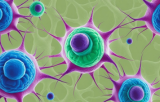Neural stem cells (NSCs) are multipotent, self-renewing cells capable of generating the three principal cell types of the central nervous system (CNS): neurons, astrocytes, and oligodendrocytes. They play a fundamental role during embryonic development by producing the diverse neural populations that form the brain and spinal cord. In the adult mammalian brain, NSCs persist in specialized niches such as the subventricular zone (SVZ) of the lateral ventricles and the subgranular zone (SGZ) of the hippocampal dentate gyrus, where they contribute to neurogenesis and neural plasticity throughout life. The balance between NSC quiescence, proliferation, and differentiation is tightly regulated by intrinsic genetic and epigenetic programs as well as extrinsic signals from the microenvironment or niche.
Developmental Origin and Differentiation
During embryogenesis, NSCs arise from the neuroectoderm and initially expand through symmetric divisions to increase the stem cell pool. They then transition to asymmetric divisions, producing lineage-restricted progenitors that differentiate sequentially into neurons, astrocytes, and oligodendrocytes in a temporally defined manner. Radial glial cells, a specialized form of NSCs located in the ventricular zone, serve as primary progenitors generating the diverse neural cell types in the developing CNS. In adult brains, NSCs maintain a more limited but significant capacity to generate new neurons and glial cells, supporting brain plasticity and repair. Epigenetic modifications such as DNA methylation and demethylation critically regulate NSC fate decisions during development and in adulthood.
Adult Neural Stem Cell Niches and Function
In the adult brain, NSCs reside in specialized niches composed of blood vessels, astrocytes, microglia, ependymal cells, and extracellular matrix components that provide structural support and molecular cues to maintain NSC quiescence or activate proliferation. Upon activation, quiescent NSCs (Type B cells) give rise to transient amplifying progenitors (Type C cells), which further differentiate into neuroblasts (Type A cells). These neuroblasts migrate to target regions such as the olfactory bulb and hippocampus, where they mature into functional neurons. Growth factors like epidermal growth factor (EGF) and fibroblast growth factor (FGF) promote NSC proliferation in vitro, and similar signaling pathways regulate NSC behavior in vivo. Dysregulation of NSCs has been implicated in neurodevelopmental disorders, neurodegeneration, and brain tumors, highlighting their importance in both health and disease.


